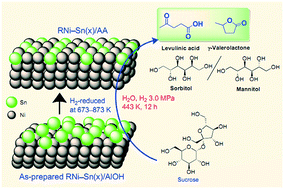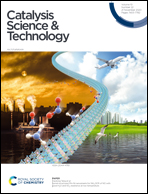Recent progress in the direct synthesis of γ-valerolactone from biomass-derived sugars catalyzed by RANEY® Ni–Sn alloy supported on aluminium hydroxide†
Abstract
The direct synthesis of γ-valerolactone (GVL) from biomass-derived sugars (e.g., cellobiose, sucrose, glucose, and fructose) using RANEY® nickel–tin alloy supported on aluminium hydroxide (RNi–Sn(x)/AlOH; x is the loading amount of Sn) catalysts has been investigated. A RNi–Sn(1.04)/AlOH (1.04 = loading amount of Sn (mmol)) catalyst exhibited the highest yield of GVL from cellobiose (37%), sucrose (67.3%), glucose (71.6%), and fructose (74.9%), whereas conventional RANEY® Ni and RNi/AlOH catalysts produced only C-6 sugar alcohols (sorbitol & mannitol) at 443 K, H2 3.0 MPa for 12 h. The reduction of RNi–Sn(x)/AlOH with H2 at 673–873 K for 1.5 h resulted in the formation of Ni–Sn alloy phases (e.g., Ni3Sn and Ni3Sn2) and caused the transformation of aluminium hydroxide (AlOH) to amorphous alumina (AA). The RNi–Sn(2.14)/AA 873 K/H2 catalyst contained a Ni3Sn2 alloy as the major phase, which exhibited the best yield of GVL from sucrose (65.3%) under the same reaction conditions. The RNi–Sn(1.04)/AlOH catalyst was reusable and stable for at least five consecutive reaction runs.



 Please wait while we load your content...
Please wait while we load your content...